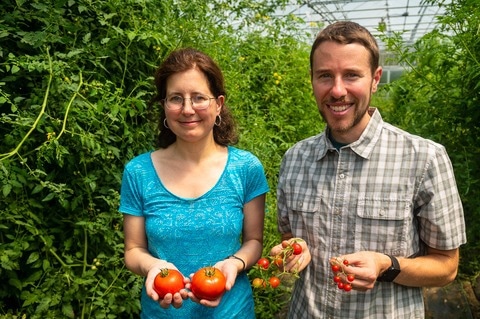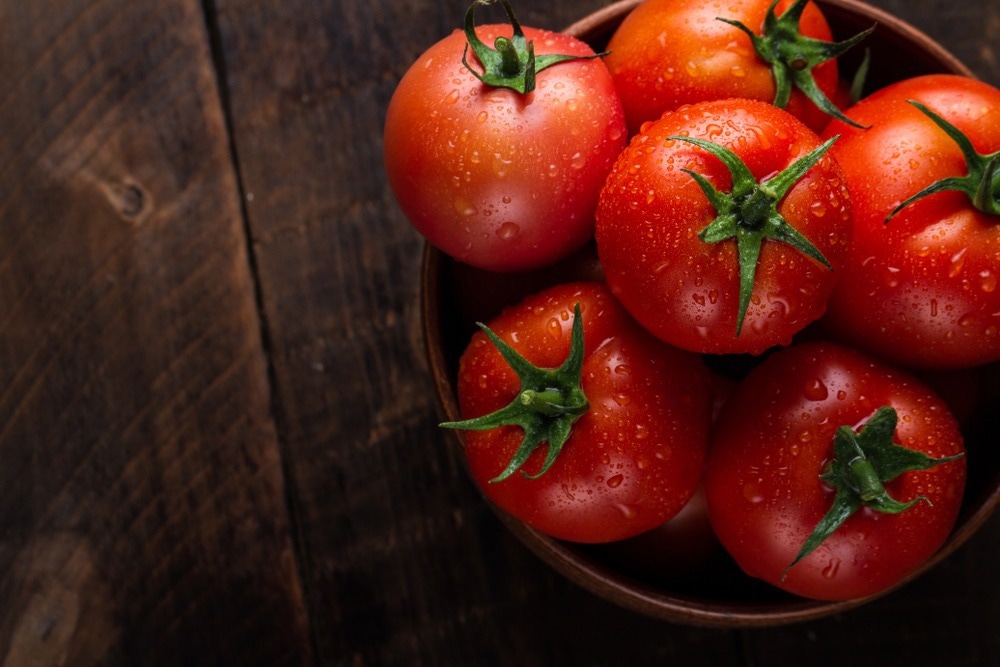Reviewed by Danielle Ellis, B.Sc.Sep 12 2023
Biologists from the University of Massachusetts Amherst have uncovered evidence of evolutionary “syndromes”—a set of traits that co-occur. These syndromes provide insights into the initial development of tomatoes, including their unique combination of color, sweetness, acidity, and aroma.
 Ana Caicedo and Jacob Barnett. Image Credit: University of Massachusetts Amherst
Ana Caicedo and Jacob Barnett. Image Credit: University of Massachusetts Amherst
The research, published in Plants People Planet and The American Journal of Botany, not only enhances our understanding of natural fruit evolution but also holds significance for endeavors focused on enhancing crops by breeding more nutritious and attractive fruit varieties.
“Have you ever held a fresh tomato in your hand and wondered why it looks good, smells good, and tastes delicious?” asks Jacob Barnett, Graduate Student in organismic and evolutionary biology at UMass Amherst and the papers’ lead author.
Juicy, red tomatoes renowned for their distinctive flavor have undergone a complex and extended evolutionary journey.

Image Credit: goffkein.pro/Shutterstock.com
To investigate this phenomenon, Barnett and his co-authors, including Ana Caicedo, a Biology Professor at UMass Amherst, delved into the study of tomato’s progenitors—several wild species thriving along the western coast of South America, stretching from Chile to Ecuador. These wild counterparts bear little resemblance to the tomatoes typically encountered in contemporary sandwiches or salads.
For one thing, they’re tiny, “about the size of a blueberry. And most of them are green when ripe. Many smell like apples, melons, or even cucumbers, and a number of them taste terrible.”
Jacob Barnett, Graduate Student, Organismic and Evolutionary Biology, University of Massachusetts Amherst
How did tomatoes transform from being small, green, unpalatable, and possessing a melon-like aroma into the delightful combination of color, sweetness, acidity, and umami that makes them a staple in pasta sauces, salads, and pizzas?
The answer lies in the fact that wild fruits typically exhibit specific sets of co-occurring traits, referred to as syndromes by biologists. For instance, many wild fruits tend to be petite, brightly colored, and rich in sugar. However, the challenge in understanding evolutionary syndromes in wild tomatoes stemmed from the lack of previous research that simultaneously cultivated all the various species of wild tomatoes.
“These two studies are the first to look at fruit traits across all species in the entire tomato group. We have been able to tell a comprehensive story of how wild tomatoes compare to each other and to our modern, cultivated varieties,” says Caicedo.
A crucial part of this revolves around the collection endeavors led by Charles Rick, affiliated with the University of California Davis. During the 1950s and 1960s, Rick embarked on expeditions across South America, amassing seeds from various wild tomato species. These seeds eventually found their home in what later became the C.M. Rick Tomato Genetics Resource Center.
Barnett and Caicedo obtained seeds from a total of 13 wild tomato species, alongside seeds from multiple distinct variants within each species. Subsequently, they cultivated these seeds at the UMass Crop and Animal Research and Education Farm, located in South Deerfield, Massachusetts.
When the plants reached maturity, they appeared “wild and scraggly,” as described by Caicedo. At one juncture, Barnett had to use a machete to clear a path through the dense growth to access their fruits and leaves.
In the laboratory, the team conducted various analyses. They examined the fruits to assess their color and shape, gauged the sugar and acid levels, and scrutinized the DNA within the leaf samples.
To comprehensively understand the scent of tomatoes, Denise Tieman, a research assistant professor at the University of Florida and a co-author, aided Barnett in the measurement and categorization of the volatile organic compounds present in each sample—these compounds are responsible for the distinct smell of tomatoes.
The team’s findings went beyond the co-occurrence of smell, flavor, and color traits, as they also unveiled what Barnett terms an “honest signal.” This signal signifies a correspondence between the external appearance of the tomato and its nutritional composition.
This alignment lends support to a contentious hypothesis: that animal preferences have played a pivotal role in shaping the evolution of fruit syndromes. Animals, it is proposed, make choices based on their ability to associate a fruit’s appearance with its distinct nutritional benefits, ultimately influencing the evolution of these syndromes.
The small, green, and melon-scented tomatoes might be the top choice for small mammals, while the sweet, colorful tomatoes are probably favored by birds. However, it remains a puzzle as to why humans developed a preference for tomatoes which are also loved by birds.
In fact, the authors highlight the need for additional field studies to definitively identify which animals are consuming particular types of fruits: “There is currently no systematic data on which animals eat wild tomato fruits.”
UMass Researchers Study Wild Tomatoes
Video Credit: University of Massachusetts Amherst
Source:
Journal references:
Barnett, J. R., et al. (2023). Evidence of fruit syndromes in the recently diverged wild tomato clade opens new possibilities for the study of fleshy fruit evolution. Plants, People, Planet. doi.org/10.1002/ppp3.10399.
Barnett, J. R., et al. (2023). Variation in ripe fruit volatiles across the tomato clade: an evolutionary framework for studying fruit scent diversity in a crop wild relative. American Journal of Botany. doi.org/10.1002/ajb2.16223.